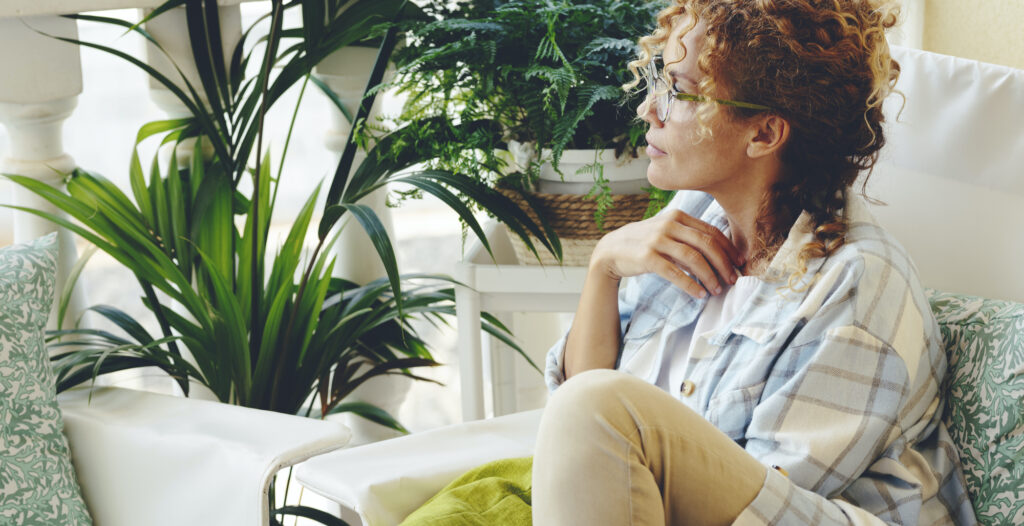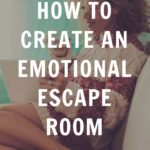How to Create an Emotional Escape Room
There’s a new design trend geared toward helping you find peace and serenity in the comfort of your home: an emotional escape room. Here you’ll find why you might want one and how to create it without any remodeling.

As a parent, it’s easy to feel like there’s not one space you can call your own. Suction cupped toy nets hang in the tub, a Montessori kitchen butts up against your real kitchen counter, toy baskets reside in corners here and there throughout the house.
We even offer our kids their own spaces like a playroom or a calm down corner. So, why shouldn’t we designate a space for ourselves to unwind and release the pressures of the day?
It’s normal to want a little space from both your family and their things from time-to-time.
But where to go?
A “she shed” or “man cave” require extra space that many of us just don’t have. Not to mention time and money to construct and outfit. Plus some parents aren’t fans of the gendered-ness of such places.
For all those reasons and more, it’s a worthwhile endeavor to reclaim your bedroom and designate it as your emotional escape room, any time of day.
Why do parents need an emotional escape room?
Parents today are feeling, burned-out, touched-out and – quite frankly – want nothing more than a time out. Tiny people follow us into the bathroom, their little fingers poke our eyes and smudge nearly every surface in sight, their adorable faces make appearances on our conference calls. Their need for us is overwhelming in all of the best ways, but sometimes we feel that flood of necessity in some not so great ways, too.
According to the International Journal of Environmental Research and Public Health, burnout is characterized by emotional exhaustion, depersonalization and a decrease in self-fulfillment as a result of chronic exposure to emotionally draining environments. And no matter how hard it might be to admit, at times, the emotionally draining environment can be your very own home.
Focus on healing your nervous system
Recognizing that you are in need of a break is not a failure in any sense of the word. It’s hard to parent from a place of connection when we feel frazzled. And children pick up on our energy. One of the best ways to help your child feel calm and safe is to regulate your nervous system first.
If you often feel overwhelmed, stuck, unfocused, or fearful, your central nervous system (CNS) probably needs tending. Alongside the stresses of work, relationships, finances, deadlines… etc., there is a whole other level of stress we put ourselves under that shuts down our nervous system and adrenals. Not responding to our nervous system properly makes it shut down.
Your emotional escape room should calm your nervous system. Other ways to tend to your CNS include breathing deeply into your lower back rib area, shaking your body, tapping (EFT), singing, and getting plenty of rest and hydration.
And, taking the time to acknowledge how you truly feel and then providing yourself with the space you need is a parenting win that needs more praise.
How to set up your emotional escape room
If your home has a spare room or extra space (bonus room, basement, sun room, or alcove), claim it as your own. If not, your bedroom can serve as an escape if you equip it properly. Your bedroom should be a place where you can relax, recoup, and revive your body and spirit.
Make sure this area is free from clutter. Too many distractions or reminders of things you need to do will rob you of relaxation. And be sure to set some ground rules around when family members can interrupt you in your own individual space.
No matter which room or section of a room you choose, here’s how to create an emotional escape space that can help foster peace of mind.
Make it a no-tech or low-tech space
The top bedroom Feng Shui tips include keeping screens and work out of your rest environment. That means no TV or computers.
But if space is tight, separate your work area with a curtain or screen divider. If watching your favorite show is part of your unwind routine, keep a tablet in your nightstand drawer.
Choose a soothing color palette
Color psychology is a real thing and there are stress relieving colors that can help set the tone for your emotional escape space. Soft blues are thought to be the most calming, but some pale greens, pinks, grays, and violets can also very peaceful color choices.
Use mood lighting
Light candles. Install a dimmer switch or relaxing lights. Add a Himalayan salt lamp. Soothing light will help take the edge off even the most difficult days. If adding a dimmer switch is too complicated, opt for some candles with relaxing scents.
Bring nature in
Plants can also be great mood boosters. Consider some greenery that doesn’t require too much care. Be sure to avoid plants that are dangerous to kids and pets.
Use a room divider
There are some gorgeous privacy screens and room dividers available. Use one to section off your own escape space from another room. Behind the barrier can be your own private sanctuary, free from distraction and the rest of the family’s stuff.
Use essential oils
Scent can impact how we feel. Add a diffuser or multi use humidifier to the space. Lavender, chamomile, and peppermint are all great scents to have on hand when looking to relax.
Welcome creativity
Expressing yourself creatively is an amazing escape from day to day life. Give your space and open and creative vibe. Bring in art supplies for drawing, painting, or crafting. Keep notebooks and awesome pens handy for journaling and releasing emotions. Clear a space for dancing, singing, or whatever else inspires you.
Bring in all your relaxation tools
What will make this space feel like a safe haven? Cozy blankets, a yoga mat, your favorite crystals… anything that helps you relax should have a permanent home here. Certain crystals can help balance the chakras, which can lead to overall wellbeing and less anxiety. CBD is becoming more accessible and better regulated. There are many CBD products created with the purpose of relaxing your mind and body.
Practice guided meditation
Meditation rooms also top the list of wellness trends lately. Use the alone time to quiet your mind with meditation on your own or with the help of guided meditation scripts or a relaxation app. Meditating in safe spaces can deepen your connection with yourself.
Add some room for reading
A good book is the ultimate escape. Tiny libraries are also a growing home trend. Whether you include a bookcase or have just enough space for a few books at a time, reading is one of the most rewarding habits around. And it rubs off on your kids. Just be warned, they’ll probably want their own reading nook.
Do something you did before you had kids
Pick back up an old hobby. Read that book you’ve had on your reading list for months. Use the time spent in your room to truly serve yourself.
Me-time can benefit the greater good
Remember that needing a place to call your own and some time to yourself doesn’t mean that you love your family any less. In fact, giving yourself an emotional escape when you feel overwhelmed can help you be both a better parent and partner.
Still, we know that sometimes escaping is not an option. In those moments when you can’t get the physical space you need, consider looking to calming tactics like these mantras and affirmations for parents to get you through the tough times.

